编译原理课件1
- 格式:ppt
- 大小:1.09 MB
- 文档页数:19
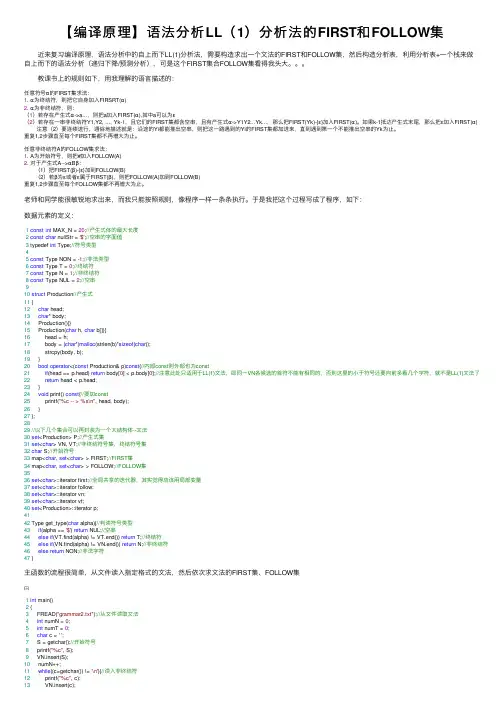
【编译原理】语法分析LL(1)分析法的FIRST和FOLLOW集 近来复习编译原理,语法分析中的⾃上⽽下LL(1)分析法,需要构造求出⼀个⽂法的FIRST和FOLLOW集,然后构造分析表,利⽤分析表+⼀个栈来做⾃上⽽下的语法分析(递归下降/预测分析),可是这个FIRST集合FOLLOW集看得我头⼤。
教课书上的规则如下,⽤我理解的语⾔描述的:任意符号α的FIRST集求法:1. α为终结符,则把它⾃⾝加⼊FIRSRT(α)2. α为⾮终结符,则:(1)若存在产⽣式α->a...,则把a加⼊FIRST(α),其中a可以为ε(2)若存在⼀串⾮终结符Y1,Y2, ..., Yk-1,且它们的FIRST集都含空串,且有产⽣式α->Y1Y2...Yk...,那么把FIRST(Yk)-{ε}加⼊FIRST(α)。
如果k-1抵达产⽣式末尾,那么把ε加⼊FIRST(α) 注意(2)要连续进⾏,通俗地描述就是:沿途的Yi都能推出空串,则把这⼀路遇到的Yi的FIRST集都加进来,直到遇到第⼀个不能推出空串的Yk为⽌。
重复1,2步骤直⾄每个FIRST集都不再增⼤为⽌。
任意⾮终结符A的FOLLOW集求法:1. A为开始符号,则把#加⼊FOLLOW(A)2. 对于产⽣式A-->αBβ: (1)把FIRST(β)-{ε}加到FOLLOW(B) (2)若β为ε或者ε属于FIRST(β),则把FOLLOW(A)加到FOLLOW(B)重复1,2步骤直⾄每个FOLLOW集都不再增⼤为⽌。
⽼师和同学能很敏锐地求出来,⽽我只能按照规则,像程序⼀样⼀条条执⾏。
于是我把这个过程写成了程序,如下:数据元素的定义:1const int MAX_N = 20;//产⽣式体的最⼤长度2const char nullStr = '$';//空串的字⾯值3 typedef int Type;//符号类型45const Type NON = -1;//⾮法类型6const Type T = 0;//终结符7const Type N = 1;//⾮终结符8const Type NUL = 2;//空串910struct Production//产⽣式11 {12char head;13char* body;14 Production(){}15 Production(char h, char b[]){16 head = h;17 body = (char*)malloc(strlen(b)*sizeof(char));18 strcpy(body, b);19 }20bool operator<(const Production& p)const{//内部const则外部也为const21if(head == p.head) return body[0] < p.body[0];//注意此处只适⽤于LL(1)⽂法,即同⼀VN各候选的⾸符不能有相同的,否则这⾥的⼩于符号还要向前多看⼏个字符,就不是LL(1)⽂法了22return head < p.head;23 }24void print() const{//要加const25 printf("%c -- > %s\n", head, body);26 }27 };2829//以下⼏个集合可以再封装为⼀个⼤结构体--⽂法30set<Production> P;//产⽣式集31set<char> VN, VT;//⾮终结符号集,终结符号集32char S;//开始符号33 map<char, set<char> > FIRST;//FIRST集34 map<char, set<char> > FOLLOW;//FOLLOW集3536set<char>::iterator first;//全局共享的迭代器,其实觉得应该⽤局部变量37set<char>::iterator follow;38set<char>::iterator vn;39set<char>::iterator vt;40set<Production>::iterator p;4142 Type get_type(char alpha){//判读符号类型43if(alpha == '$') return NUL;//空串44else if(VT.find(alpha) != VT.end()) return T;//终结符45else if(VN.find(alpha) != VN.end()) return N;//⾮终结符46else return NON;//⾮法字符47 }主函数的流程很简单,从⽂件读⼊指定格式的⽂法,然后依次求⽂法的FIRST集、FOLLOW集1int main()2 {3 FREAD("grammar2.txt");//从⽂件读取⽂法4int numN = 0;5int numT = 0;6char c = '';7 S = getchar();//开始符号8 printf("%c", S);9 VN.insert(S);10 numN++;11while((c=getchar()) != '\n'){//读⼊⾮终结符12 printf("%c", c);13 VN.insert(c);14 numN++;15 }16 pn();17while((c=getchar()) != '\n'){//读⼊终结符18 printf("%c", c);19 VT.insert(c);20 numT++;21 }22 pn();23 REP(numN){//读⼊产⽣式24 c = getchar();25int n; RINT(n);26while(n--){27char body[MAX_N];28 scanf("%s", body);29 printf("%c --> %s\n", c, body);30 P.insert(Production(c, body));31 }32 getchar();33 }3435 get_first();//⽣成FIRST集36for(vn = VN.begin(); vn != VN.end(); vn++){//打印⾮终结符的FIRST集37 printf("FIRST(%c) = { ", *vn);38for(first = FIRST[*vn].begin(); first != FIRST[*vn].end(); first++){39 printf("%c, ", *first);40 }41 printf("}\n");42 }4344 get_follow();//⽣成⾮终结符的FOLLOW集45for(vn = VN.begin(); vn != VN.end(); vn++){//打印⾮终结符的FOLLOW集46 printf("FOLLOW(%c) = { ", *vn);47for(follow = FOLLOW[*vn].begin(); follow != FOLLOW[*vn].end(); follow++){48 printf("%c, ", *follow);49 }50 printf("}\n");51 }52return0;53 }主函数其中⽂法⽂件的数据格式为(按照平时做题的输⼊格式设计的):第⼀⾏:所有⾮终结符,⽆空格,第⼀个为开始符号;第⼆⾏:所有终结符,⽆空格;剩余⾏:每⾏描述了⼀个⾮终结符的所有产⽣式,第⼀个字符为产⽣式头(⾮终结符),后跟⼀个整数位候选式的个数n,之后是n个以空格分隔的字符串为产⽣式体。

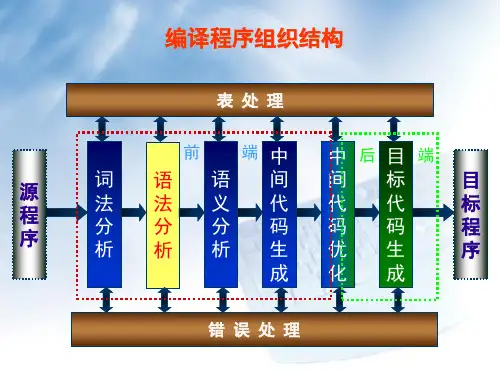


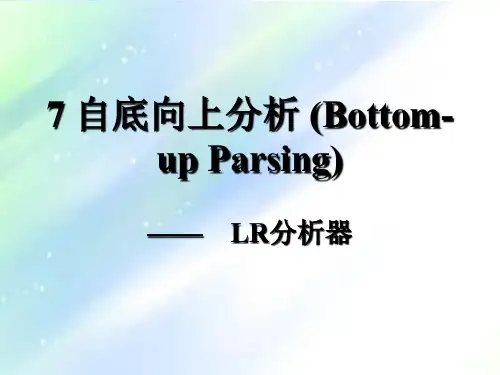
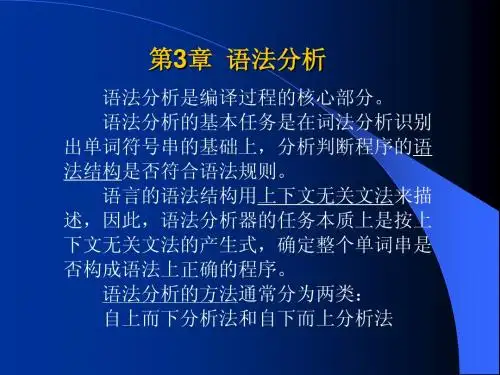

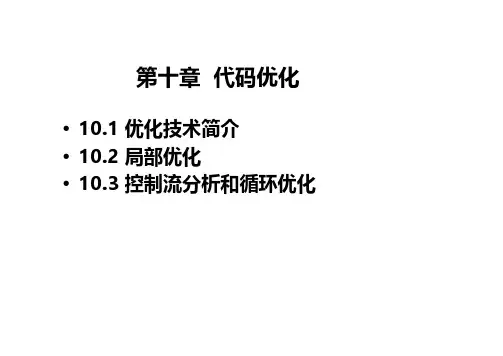


一、实验目的及要求1.掌握LL(1)分析法的基本原理;2.掌握LL(1)分析表的构造方法;3.用LL(1)分析法分析高级语言表达式。
4、了解LL(1)分析器的工作过程。
文法:无二义性的算术表达式的文法(1)把词法分析作为语法分析的子程序实现(5分)(2)独立的语法分析程序(4分)(3)对表达式文法消除左递归、构造LL(1)分析表(4)LL(1)分析表可以直接输入(4分),也可以用程序实现(5分)(5)给一个表达式,给出分析过程(分析栈、输入串、所用规则)(4分)(6)生成一个棵语法树(5分)用二叉树的形式表示出来二、实验内容及原理1、实验原理(1)、LL(1)文法的定义LL(1)分析法属于确定的自顶向下分析方法。
LL(1)的含义是:第一个L表明自顶向下分析是从左向右扫描输入串,第2个L表明分析过程中将使用最左推导,1表明只需向右看一个符号便可决定如何推导,即选择哪个产生式(规则)进行推导。
LL(1)文法的判别需要依次计算FIRST集、FOLLOW集和SELLECT集,然后判断是否为LL(1)文法,最后再进行句子分析。
需要预测分析器对所给句型进行识别。
即在LL(1)分析法中,每当在符号栈的栈顶出现非终极符时,要预测用哪个产生式的右部去替换该非终极符;当出现终结符时,判断其与剩余输入串的第一个字符是否匹配,如果匹配,则继续分析,否则报错。
LL(1)分析方法要求文法满足如下条件:对于任一非终极符A的两个不同产生式A→α,A→β,都要满足下面条件:SELECT(A→α)∩SELECT(A→β)=∅(2)、预测分析表构造LL(1)分析表的作用是对当前非终极符和输入符号确定应该选择用哪个产生式进行推导。
它的行对应文法的非终极符,列对应终极符,表中的值有两种:一是产生式的右部的字符串,一是null。
若用M表示LL(1)分析表,则M可表示如下:M: VN×VT→P∪{Error}M(A, t) = A→α,当t∈select(A→α) ,否则M(A, t) = Error其中P表示所有产生式的集合。
现代编译原理--第⼆章(语法分析之LR(1)) (转载请表明出处)前⾯已经介绍过LL(1),以及如何使⽤LL(1)⽂法。
但是LL(K)⽂法要求在看到K个字母的情况下必须做出预测,这相⽐于LR(K)⽂法⽽⾔就逊⾊很多。
LR(K)⽂法的定义是:从左⾄右分析,最右推导,超前查看K个单词。
先看⼀个例⼦,来对LR⽂法有个⼤致的印象。
以上就是使⽤LR⽂法对源码进⾏分析的例⼦。
注意到在LR⽂法中只有三个动作:移进,规约和接受,这三个动作也是通过查表来得到的。
任何时候如果都是唯⼀确定这三个动作中的⼀个,我们就能让LR⽂法正确的运⾏。
为了更好的理解LR(K)⽂法,我们先介绍以下最简单的LR(0)⽂法。
因为动作是根据表来确定,所以,表的构建依然是我们构建的重点,先来看看⼀个表的最终形式: ⾸先要说明的是,构建这张表的时候,我们使⽤到了状态机,⾏标就代表状态。
列标由两部分组成,分别是终结符,和⾮终结符。
s代表移进,r代表规约,g代表跳转,a代表接受,他们后⾯跟着的数字,除了r以外,都是状态的标号,只有r后⾯的数字指的时规约到第⼏个产⽣式。
所有空的地⽅都代表出现错误。
可见在⾮终结符下只有跳转。
为了构建这个表,我们⾸先构建状态机。
我们从⼀个基本的⽂法开始,⽂法如下: 我们向产⽣式中添加⼀个点,形成这种形式,称为项。
这个点的位置告诉我们当前在状态是什么。
点每移动⼀次,我们跳转⼀个状态。
点前⾯的字符串表⽰我们已经读取的历史,点后⾯的字符串表⽰我们希望得到的。
也就是这种表达⽅式,既可以展望未来,也可以回顾过去。
上⾯这个起始项中,我们希望得下⼀次得到⼀个S⾮终结符,可以看出1和2产⽣式是S的等价形式,如果我们得到1和2产⽣式的右部,我们就相当于得到了⾮终结符S,所以,我们的起始状态为: 我们称第⼀个产⽣式为核⼼项,其他为普通项。
这个状态我们称为状态1,所有的状态都是由这个状态中每个项的点的移动得到的。
例如,状态1吃掉⼀个终结符x时,状态1的第⼆个项中的点要向右移动⼀位。